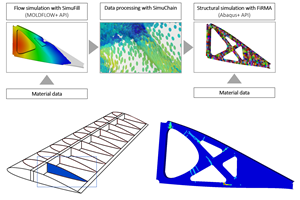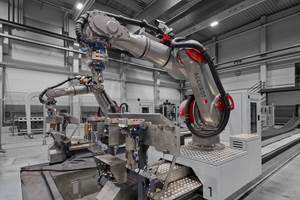Shelby GT350R features carbon fiber wheels
Ford worked with Australia-based Carbon Revolution to develop the one-piece all-carbon fiber wheels, which save 60 lb in weight but provide better steering response.
Share
Ford Motor Co. (Dearborn, MI, US) reported on July 10 that its Shelby GT350R track-capable Mustang will offer carbon fiber wheels as standard equipment. The wheels are being supplied by Carbon Revolution (Waurn Ponds, Australia).
Ford says that in early testing with benchmark vehicles, prototype wheels showed significant potential — improving suspension response times, chassis dynamics, steering feel and ride quality. When the decision was made to pursue this technology for use in a production vehicle, the engineering team was challenged to develop a wheel that met Ford’s strict standards for durability, quality, craftsmanship and premium finish.
Ford notes that reducing overall curb weight in general is beneficial to a car’s dynamics, but a reduction in unsprung weight (those components not supported by the suspension) can have a significant impact on handling and performance. Less unsprung weight helps vehicles start, stop and turn faster by reducing wheel rotational inertia, dramatically improving response time to driver input. Lower unsprung weight also translates to suspension components not having to work so hard to keep the tires in contact with the road over undulating or broken surfaces.
Ford says that although Carbon Revolution has been the leading manufacturer of carbon fiber wheels, both Ford and the supplier recognized significant innovation was needed to meet Shelby GT350R program needs. This project would set the standard for mass-produced carbon fiber wheels.
One of the most severe tests for wheels in the Ford development process involves striking a curb at speed — a test that, without proper design, can cause serious wheel and tire damage. Because of the light weight, advanced construction methods and resins in the wheels, along with the highly-developed MagneRide dampers, the suspension was able to react so quickly that the driver wasn’t sure the test had been carried out correctly and ran it twice to be sure. The suspension response was fast enough to greatly diminish the severity of the impact – that’s the power of minimizing unsprung weight.
During track testing the extreme performance capabilities of the braking system developed heat that required the maximum technology available from Carbon Revolution. When brake temperature measurements were taken, it was revealed Shelby GT350R’s ultra-powerful brakes were creating rotor temperatures in excess of 900°C. As a result, the wheel design was elevated from a road car specification to a thermal standard more suitable for motorsports.
For decades aerospace companies have treated turbine blade materials subject to extreme heat with ceramic coatings to help improve durability. The technology is also used in top-tier open-wheel racing environments. A thermal barrier coating system developed by Carbon Revolution uses this same technology.
Created specifically for motorsport and aerospace applications where extreme temperature conditions are encountered, Carbon Revolution’s thermal barrier coating system uses a multistage, multimaterial coating formulation that provides an excellent thermal barrier. Using a plasma arc gun to liquefy a ceramic material, the wheels are coated at critical points around the inner wheel “barrel” and on the back of the spokes. The result is an incredibly thin, nearly diamond-hard coating that reliably shields the resin from heat, reducing maximum wheel temperatures and allowing continuous track use by even the most aggressive drivers.
Ford also learned that upon extreme exposure to harsh UV environments, corrosive salts and road chemicals, it became apparent that to achieve the durability required, a special coating would need to be developed to protect the resin from the environment.
Further, carbon fiber parts are notoriously challenging when it comes to delivering a flawlessly smooth painted surface — the kind of finish Ford demands for all of its vehicles. Several proprietary new processes were developed that resulted in a robust, high-gloss black finish that not only looks good, but ensures a long life for the wheels.
The wheel is molded in one piece. As it cures, 61 individual checks and more than 246,000 data points are logged before it’s released from the machine. To guarantee quality parts, the cured wheels are analyzed using a 3D computerized tomography (CT) imaging process in which more than 18,000 X-ray images are taken. If the wheel passes inspection, it undergoes machining for the valve stem and mounting hardware holes before it is painted, coated, assembled, dimensionally checked and shipped to for installation on a new Shelby GT350R Mustang.
By cutting the weight of each wheel nearly in half compared to an equivalent aluminum wheel (18 lb vs. 33 lb), handling and acceleration performance see substantial benefits. The wheels also provide a reduction in rotational inertia of more than 40%, which positively impacts acceleration and braking performance. The wheels are so light, the springs and MagneRide dampers had to be recalibrated because the suspension can respond considerably faster to road inputs.
Related Content
Carbon fiber, bionic design achieve peak performance in race-ready production vehicle
Porsche worked with Action Composites to design and manufacture an innovative carbon fiber safety cage option to lightweight one of its series race vehicles, built in a one-shot compression molding process.
Read MoreImproving carbon fiber SMC simulation for aerospace parts
Simutence and Engenuity demonstrate a virtual process chain enabling evaluation of process-induced fiber orientations for improved structural simulation and failure load prediction of a composite wing rib.
Read MoreAutomated robotic NDT enhances capabilities for composites
Kineco Kaman Composites India uses a bespoke Fill Accubot ultrasonic testing system to boost inspection efficiency and productivity.
Read MoreOptimized approach to predict delamination failure in CFRTP structures
ARRK Engineering and Mitsui Chemicals improved delamination prediction accuracy to help optimize absorbed energy/failure load for an overmolded TAFNEX CF/PP UD tape bumper beam.
Read MoreRead Next
Plant tour: Daher Shap’in TechCenter and composites production plant, Saint-Aignan-de-Grandlieu, France
Co-located R&D and production advance OOA thermosets, thermoplastics, welding, recycling and digital technologies for faster processing and certification of lighter, more sustainable composites.
Read More“Structured air” TPS safeguards composite structures
Powered by an 85% air/15% pure polyimide aerogel, Blueshift’s novel material system protects structures during transient thermal events from -200°C to beyond 2400°C for rockets, battery boxes and more.
Read MoreAll-recycled, needle-punched nonwoven CFRP slashes carbon footprint of Formula 2 seat
Dallara and Tenowo collaborate to produce a race-ready Formula 2 seat using recycled carbon fiber, reducing CO2 emissions by 97.5% compared to virgin materials.
Read More

























